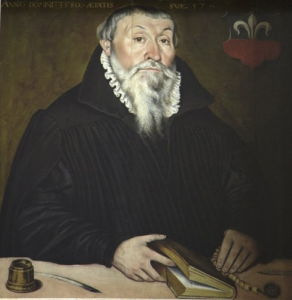Commemoration of Martin Chemnitz (birth), Pastor and Confessor
November, 9
The Lord be with you
Si Martinus non fuisset, Martinus vix stetisset. So goes the little rhyming quip, in Latin, that Roman Catholics used to describe Martin Chemnitz. It means, “If the second Martin had not come, the first Martin would not have stood.” His Roman Catholic opponents recognized how important Chemnitz was to the legacy of Martin Luther and came up with this phrase after Chemnitz wrote The Examination of the Council of Trent.
 Aside from Martin Luther, Martin Chemnitz (November 9, 1522 – April 8, 1586) is regarded as the most important theologian in the history of the Lutheran Church and unquestionably the greatest second-generation Lutheran theologian. Chemnitz combined a penetrating intellect and an almost encyclopedic knowledge of Scripture and the Church Fathers with a genuine love for the Church. When various doctrinal disagreements broke out after Luther’s death in 1546, Chemnitz determined to give himself fully to the restoration of unity in the Lutheran Church. He became the leading spirit and principal author of the 1577 Formula of Concord, which settled the doctrinal disputes on the basis of Scripture and largely succeeded in restoring unity among Lutherans. He was also instrumental in the publication of the definitive Book of Concord in 1580, the doctrinal standard of the Lutheran Church. Chemnitz also authored the four volume The Examination of the Council of Trent (1565–73) in which he rigorously subjected the teachings of this Roman Catholic Council to the judgment of Scripture and the ancient Church Fathers. The Examination became the definitive Lutheran answer to the Council of Trent, as well as a thorough exposition of the faith of the Augsburg Confession. A theologian and a churchman, Chemnitz was truly a gift of God to the Church.
Aside from Martin Luther, Martin Chemnitz (November 9, 1522 – April 8, 1586) is regarded as the most important theologian in the history of the Lutheran Church and unquestionably the greatest second-generation Lutheran theologian. Chemnitz combined a penetrating intellect and an almost encyclopedic knowledge of Scripture and the Church Fathers with a genuine love for the Church. When various doctrinal disagreements broke out after Luther’s death in 1546, Chemnitz determined to give himself fully to the restoration of unity in the Lutheran Church. He became the leading spirit and principal author of the 1577 Formula of Concord, which settled the doctrinal disputes on the basis of Scripture and largely succeeded in restoring unity among Lutherans. He was also instrumental in the publication of the definitive Book of Concord in 1580, the doctrinal standard of the Lutheran Church. Chemnitz also authored the four volume The Examination of the Council of Trent (1565–73) in which he rigorously subjected the teachings of this Roman Catholic Council to the judgment of Scripture and the ancient Church Fathers. The Examination became the definitive Lutheran answer to the Council of Trent, as well as a thorough exposition of the faith of the Augsburg Confession. A theologian and a churchman, Chemnitz was truly a gift of God to the Church.
We are fortunate to have preserved a brief autobiography that Chemnitz wrote, translated into English. You can read it here: (http://books.google.com/books?id=fi8bAAAAYAAJ&pg=PA472&vq=%22An+Autobiography+of+Martin+Kemnitz%22&source=gbs_search_r&cad=1_1#v=onepage&q=%22An%20Autobiography%20of%20Martin%20Kemnitz%22&f=false) and then clicking on the link: Chemnitz Autobiography.docx. Pastor David Jay Webber, on the web site “The Brothers of John the Steadfast,” (http://steadfastlutherans.org/?s=martin+chemnitz&x=0&y=0) that has a number of articles and quotes about Chemnitz on key topics that can give you a good insight into his thinking.
In the portrait in this post, which was painted in Chemnitz’ lifetime, Chemnitz seems to have a rosary in his hand. We actually have no evidence of the use of the rosary by Chemnitz, or Lutherans. The conventions of the day when preparing portraits were very strict. Painters would routinely paint into portraits symbols of the person’s vocation and responsibilities: hence, in the portrait we see a quill pen and book, to indicate Chemnitz’ work as an author and scholar, and the rosary was included as a symbol of his faith and piety.
To my knowledge, the Lutheran Service Book is the first time Chemnitz has appeared on a liturgical calendar.
Prayer for the Day: Lord God, heavenly Father, through the teaching of Martin Chemnitz, You prepared us for the coming of Your Son to lead home His Bride, the Church, that with all the company of the redeemed we may finally enter into His eternal wedding feast; through the same Jesus Christ, our Lord, who lives and reigns with You and the Holy Spirit, one God, now and forever. Amen.
Blessings in Christ.
Pastor John Rickert
